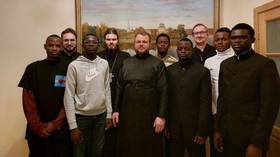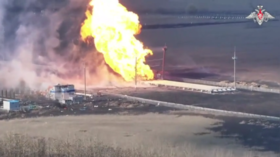Church orders removal of Stalin from icon

The Orthodox Church of Georgia has ordered changes to an icon featuring Soviet leader Joseph Stalin. Its presence in the Holy Trinity Cathedral, the second most prominent place of Christian worship in the country, has stirred controversy and led to an act of vandalism.
The icon is dedicated to Matrona Nikonova, a canonized saint of the Russian Orthodox Church, who lived most of her life in Moscow and died at the age of 70 in 1952. An apocryphal retelling of her life claims that in 1941, as Soviet troops were being pushed back by invading Nazi forces, Stalin secretly met her to ask for a blessing. Both church and secular historians have expressed skepticism over the story.
In a statement on Thursday, the Georgian Church cited the lack of recognition of the Stalin episode by its Russian counterpart, in explaining why the image needs to be changed to conform to the canons of iconography. If donors do not make the required changes, clerics will do so, the Patriarchate said.
An icon to none other but Joseph Stalin in the of the Holy Trinity Cathedral in Tbilisi. Russia is scoring solid success as both EU and US fail to recognize the central role of weaponization of memory in Russia's information warfare agenda and that of Stalin in particular pic.twitter.com/ejYE5CFngQ
— Giorgi Kandelaki (@kandelakigiorgi) January 6, 2024
Stalin, who was born in what is now independent Georgia, is a divisive figure in his homeland. Some are appalled by his tyrannical rule, and for governing a nation in which Georgia had no sovereignty. But many still view him as a national hero and a powerful leader, who allegedly tolerated no corruption.
The national Church has a mostly negative attitude, in view of the brutal anti-clerical policies of the Soviet authorities at the time, but has argued that this alone does not disqualify him from being featured on an icon. Even enemies of Christianity can be depicted persecuting the saints, according to the religious artistic canon.
The icon with Stalin caused an uproar on Christmas Eve, which Orthodox believers celebrated last week, after a video showing it at the cathedral in Tbilisi was shared by a former lawmaker. Days later, it was sprayed with blue paint, an incident currently being investigated by the Georgian police.
In a follow-up later in the day, the Church stressed that icons should be protected from vandalism and blasphemy, calling such verbal attacks an “unhealthy form of free speech.” The faithful too must express their feelings peacefully, the statement added.
The image was reportedly donated several years ago by two politicians, who lead a minor conservative nationalist party.














